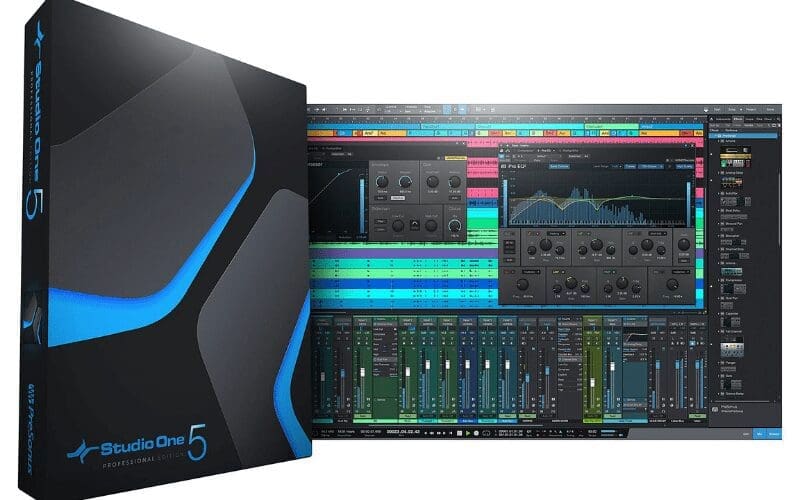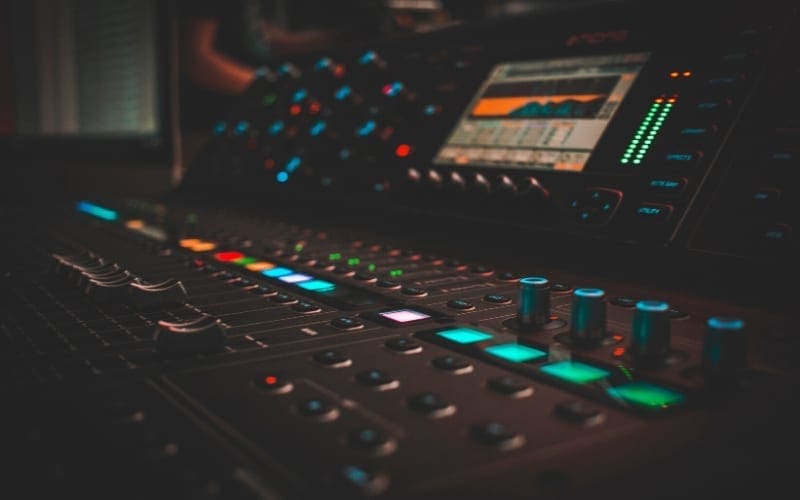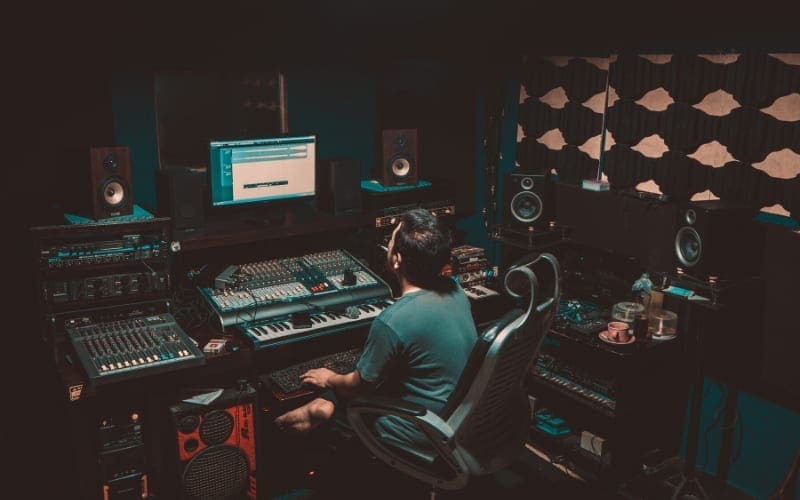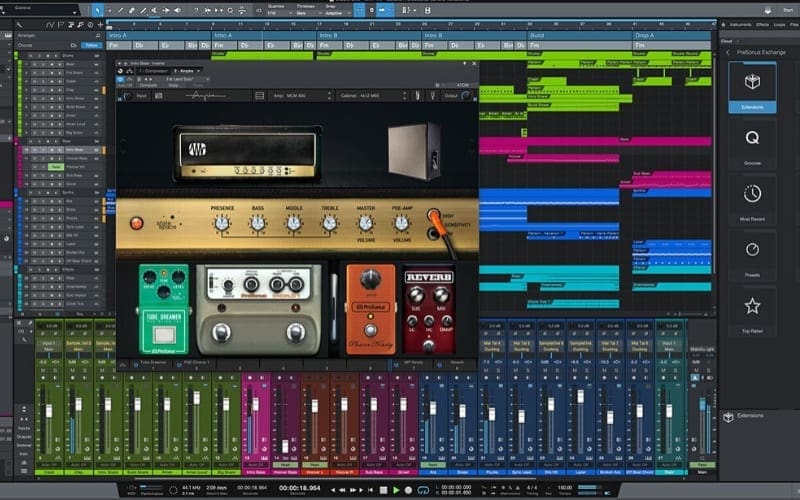
For those that aren’t aware, Digital Audio Workstations (or DAWs) are essentially a piece of software which enable users to record, edit and produce music on computers. Professional music producers spend most of their working life utilising some form of DAW. I’m going to be taking a look at PreSonus Studio One DAW.
As with all things in the pro audio industry, there are so many choices available: Pro Tools, Ableton, Logic and PreSonus, to name a few. So, which one do you pick and why?
Pro Tools has long been the industry standard, but many users are now switching to Studio One, and there’s a good reason why. In my opinion (and I’m sure others will agree), Studio One 4 offers the most sophisticated solution for all of your music production needs.
You can find all you need to know about Presonus Studio One 5 in this article.
What is Presonus Studio One?
Studio One is a DAW – but what does this DAW have to offer PreSonus Studio One artists?
Tech Specs And Features:
With an impressive list of specs and features – it’s hard to know where to start. The list is endless, including unlimited audio and instrument tracks, shortcuts, advanced ARA integration, special features such as chord tracks and pattern editors, a dedicated mastering suite and more!
Announced At The 5.0 Release:
With the 5.0 release, even more features have been announced. Some of these include a powerful, fully integrated, live-performance environment capable of running complete shows from a single computer. The Show Page combines playback of backing tracks with patch management for virtual and real instrument players inside one window. Setlist items can be rearranged and skipped. With a full-screen performance view, adaptive real-time controls and a large meter, running a show is simple.
Presonus have updated mixer scenes in Studio One 5. Users can now capture snapshots of the entire mixer at any time and can recall snapshots in a variety of different ways, with an assortment of recall options. A dedicated Listen bus is also among the improvements to the Studio One mixer, letting users monitor Solo signals through a separate output channel or tune their room using advanced calibration plug-ins while leaving their main mix unaffected.
PreSonus Studio One 5 is available in three different versions. Studio One Prime, Studio One Artist and Studio One Professional.
So, there are 3 versions of PreSonus Studio One 5. Let’s take a look at what each version offers. Each list is not a comprehensive list (as you’d be here all day!), so bear in mind that these are just some of the highlights. I will also cover Studio One pricing and compare different versions such as Studio One Artist vs Pro in my PreSonus Studio One review.

Studio One Prime | £FREE
If you’re not quite sure about taking the plunge and want to see if PreSonus DAW software is for you, take advantage of Prime. Although Prime is free, it actually offers a lot of features.
These features include:
- Arranger tracks
- MIDI editing
- A drum editor
- Custom DAW shortcuts
- Ampie, a basic guitar amp simulator
- 1.68GB of Studio One virtual instruments
- Articulations and KeySwitch editing
- Clip Gain Envelopes
- Side-by-side editors
… all for free!
Studio One Artist | £99.95
As well as all of the Prime features, Artist offers the following:
- Built-in support for VST and AU plug-ins, ReWire, and PreSonus’ Studio One Remote control software for iPad® and Android® tablets
- Unlimited audio and instrument tracks, advanced automation features, virtual instruments, buses, and FX channels
- Pristine sound quality with native 32-bit floating point resolution and support for up to 384 kHz audio
- New virtual instruments, i.e. Impact XT and SampleOne XT for powerful beat or loop-based composition, live sampling, and robust sample editing
- Patterns allow for intuitive drum and melody composition via familiar drum machine/sequencer style UI
- Aux channels
Studio One Professional | £399.95
Studio One Professional is the flagship offering from Presonus. Featuring all of the above and the following:
- Chord Track to manipulate audio and note data of any or all tracks for Harmonic Editing and song prototyping
- AAF import for easy song/session exchange with other applications for collaboration (Pro Tools, Logic, Nuendo, Final Cut Pro, Premiere etc)
- Arranger track and scratch pads
- Mastering suite
- Support for third-party sampler formats (Kontakt, EXS)
- Included with PreSonus Sphere
- Listen Bus
- Score View
How To Get Started:

I’d recommend that you start with Studio One Prime. If you don’t want to make the big leap to professional, then maybe invest in Artist. Later on, if you decide you want the full monty, you can make an upgrade at a reduced cost as you already own Studio One Artist.
If you’re a complete beginner, then head over to the PreSonus website and YouTube channel. They have lots of free tutorials on how to use the software. Studio One Expert also offers some great free blogs and video tutorials, even offering industry professionals such as Paul Drew showing how to take advantage of Studio One’s unique features and apply them to real-world situations.
How Does PreSonus Studio One Work?
Above all else, my favourite thing about PreSonus Studio One is how it works for so many different users. From artists and songwriters to seasoned mastering professionals – Studio One has a lot to offer each individual. I’ve separated the tech specs below into the different types of use (production, mixing and mastering), as I think this is the easiest way to explore all the different key features and how they can be applied.
Production Features:
Virtual Instruments
Presence XT is a full-featured sampler complete with a library and the option to add third-party samples with great parameter control, and effects.
Mai Tai is a polyphonic virtual analogue synth that offers great sound emulations of classic synths from Moog bass to lush CS80-reminiscent pads.
Mojito is a monophonic subtractive synthesiser that is a really simple synth that is great for beginners. It still has an extremely powerful and impressive sound, so don’t let that put you off if you’re a more experienced programmer. Perfect for mono bass and lead sounds.
Impact XT is a multi-channel drum sampler packing a ton of features. Similar to the legendary MPC hardware, offering drag and drop functionality for super-fast kit building. You can also map a single sample across all the pads by holding shift + alt.
Native Plugins And Note FX
With a whopping list of 41 native plugins, you’ll be spoiled for choice. Some of these are:
- Ampire XT – Guitar amplifier modeller and custom IR’s loadable.
- Auto Filter – Envelope-controlled filter
- Bitcrusher – Lo-fi and downsampling processor
- Groove Delay – Multi-tap delay with tempo sync and tap filtering
- IR Maker – Impulse response creation utility
- Level Meter – Resizable, multi-scale loudness/level meter
- Multiband Dynamics – Multiband compressor / expander
- Pro EQ – Seven-band parametric equalizer
- Room Reverb – Room simulator
- Tone Generator – Multi-waveform signal generator
- X-Trem – Tremolo / auto panner with tempo sync and step sequence modulation

Audio Manipulation
PreSonus Studio One also offers:
• Zplane elastique audio – This involves time-based algorithms which are integrated into Studio One. This enables accurate time stretching and configurable tempo mapping.
• Chord detection – The chord track allows you to depict the harmonic content from a sample, audio track or midi data. It also means you can manipulate the information later on if you decide you want to change the harmony or key of a chord.
Layout And Track Modes:
• Arranger track – A very simple way to make quick adjustments to your song’s structure. If you decide you want a chorus or verse in a different place, you can quickly and easily move the entire part including all of the automation data too.
• Scratch Pad – This is a godsend if you need to do multiple cut downs and ‘stings’ for working to picture. Often clients will ask for 15, 30 and 60-second versions of a piece of music. This takes the hard work away, and can all be done in the same session.
• Pattern mode – Pattern mode needs an entire separate article to go in-depth about its feature set. Put simply, it’s a step sequencer (similar to that of an 808) that allows you to create rhythmic and melodic patterns on a sub-dividable grid.
• Automatic aux and send routing – Coming from a Pro Tools background, this was a big one for me. When you drop a plugin insert onto a send/return, it automatically creates an AUX track. No more creating an aux track and setting up all the bus routing.
Mixing Workflow
• Groove grid – Goodbye tab to transients. Wanting to trigger some samples for a weak snare or kick drum? You no longer need 6 hours and 3 cups of coffee. Using the audio menu, you can analyse an audio part and then simply drag your track into the groove box under the quantize tab. This creates midi data which you can sample to your heart’s content. Job done!
• Advanced ARA integration – Melodyne and Synchro Arts have teamed up with Presonus to bring advanced ARA integration into the DAW. This means that if you need to tune or tighten vocal parts, you no longer have to do this externally, render it and bring it back into the session. Is anyone noticing a theme here with the time you’re going to save?
• Plugin list view – Studio One’s plugins are easy to switch between, thanks to the list view header. Plus, graphic thumbnails make it much easier to see your favourite plugins when searching for them.
• Stems – Stems are automatically consolidated when you go to render them. No more import problems when working with other DAWs!
• Store FX Chains – I use this feature a ton. For voiceover work, I have a go-to FX chain that I use to process my mic’s incoming signal. With the click of a button, I can recall this FX chain in any session.
Mastering Suite
If you master your own tracks or for clients, Studio One has its own mastering suite called the Project Page. Here, you can match songs to references, with spectral and level meters. In addition to this, you can insert plugins as inserts, pre-master and post-master – giving you the ultimate control in the final stages before making a release.
The spectral analyser has a great set of visual modes to view how the frequency of the tracks is being displayed. This can help you overcome any EQ issues your track may have against a reference.
Benefits of PreSonus Studio One:

Support & Stability
PreSonus seem to genuinely care and listen to its users: something a lot of other companies take for granted. Many of the additions to new releases, bug fixes and enhancements have come from listening to customers’ feedback.
Hardware Integration: Atom and FaderPort.
The PreSonus FaderPort is popular among many producers, as it works well with most major DAWs. However, the FaderPort is best suited to use with Studio One. Ideal for connecting with your productions on a physical level, allowing for superior control and workflow when mixing and automating levels, panning and more.
PreSonus also offers the Atom, an MPC-style controller with velocity-sensitive pads and endless rotary encoders. Perfect for beat making with Impact XT, and a great option if you want to use Studio One for live use. The rotary knobs also allow you to control plugin parameters and map custom third-party plugins to the encoders.
PreSonus Studio One Vs Other DAWs
What Sets It Apart?
Studio One offers many things other DAWs don’t. I think we can break this down into workflow, integration and feature set.
Things like the chord detector, arranger track and elastique audio could be the difference between a successful session, and a terrible one. Advanced ARA integration means Melodyne and Vocalign are just a shortcut away.
Finally, the vast number of virtual instruments and native plugins that are included with Studio One 4 Professional is astounding. No other DAW on the market offers all this, and at a price point that won’t make you say “how much?!”.
If you’re looking to expand further, I’d definitely grab the FaderPort and Atom. With these controllers, Studio One Professional 4, and a good quality interface (which you can also buy and benefit from the Magic Bundle), you’ll have everything you need to make commercial-quality productions.

Summary
Even if you’re a bit set in your ways and can’t pull yourself away from your go-to DAW, why not grab a copy of Studio One Prime for free? You might be surprised. Studio One has come an incredibly long way for what’s still considered a relatively young competitor in the world of digital audio workstations.
This is no longer the free DAW that comes bundled with a midi controller and gets chucked on top of a DVD rack (or is permanently pending download). Studio One is probably the most sophisticated all-inclusive production/composing, mixing and mastering solution on the market.










